Influences Shaping Australian Healthcare and Nursing Roles
VerifiedAdded on 2022/07/27
|8
|1933
|279
Essay
AI Summary
This essay delves into the multifaceted influences shaping healthcare provision in Australia, with a specific focus on the impact on registered nurses (RNs). The introduction highlights the significance of health provision and the involvement of both national government and private sectors under Medicare. The essay identifies female genital mutilation (FGM) and government policies as key factors. FGM, stemming from cultural practices, poses challenges for healthcare providers, including the need for specialized care, cultural competence, and addressing ethical dilemmas. Government policies, including the Health Insurance Act of 1973 and various other acts, are analyzed for their impact on healthcare access, funding, and the role of RNs. The essay discusses how these policies shape the healthcare system, influence technological advancements, and affect the quality of care. The collaborative efforts of the public and private sectors, are also emphasized. The conclusion underscores the influence of these factors on resource allocation, professional conduct, and the overall experience of healthcare access for the public. It stresses the importance of considering various societal domains when organizing public services, referencing the collaborative nature of Australian public and private sectors to ensure equitable healthcare access.
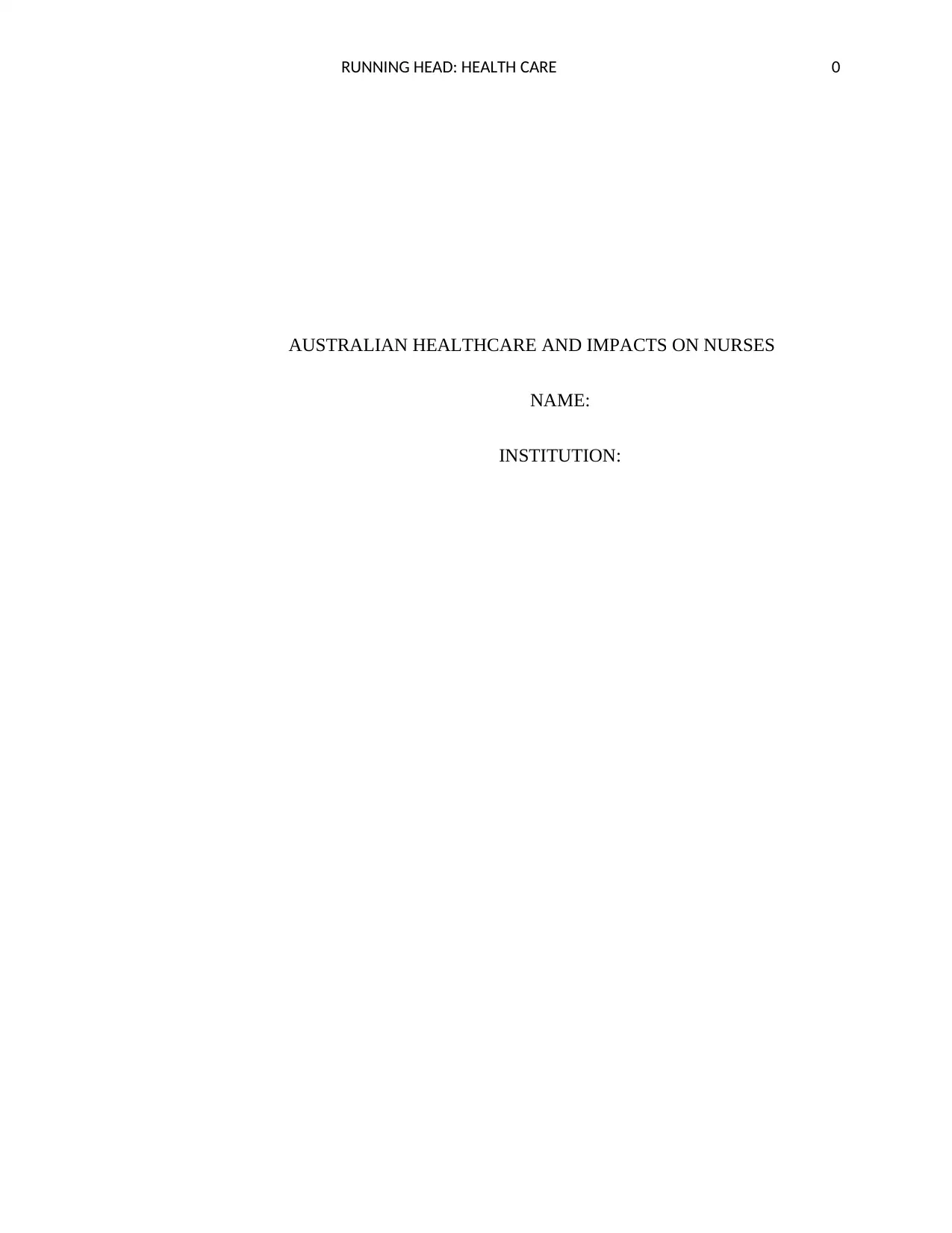
RUNNING HEAD: HEALTH CARE 0
AUSTRALIAN HEALTHCARE AND IMPACTS ON NURSES
NAME:
INSTITUTION:
AUSTRALIAN HEALTHCARE AND IMPACTS ON NURSES
NAME:
INSTITUTION:
Paraphrase This Document
Need a fresh take? Get an instant paraphrase of this document with our AI Paraphraser
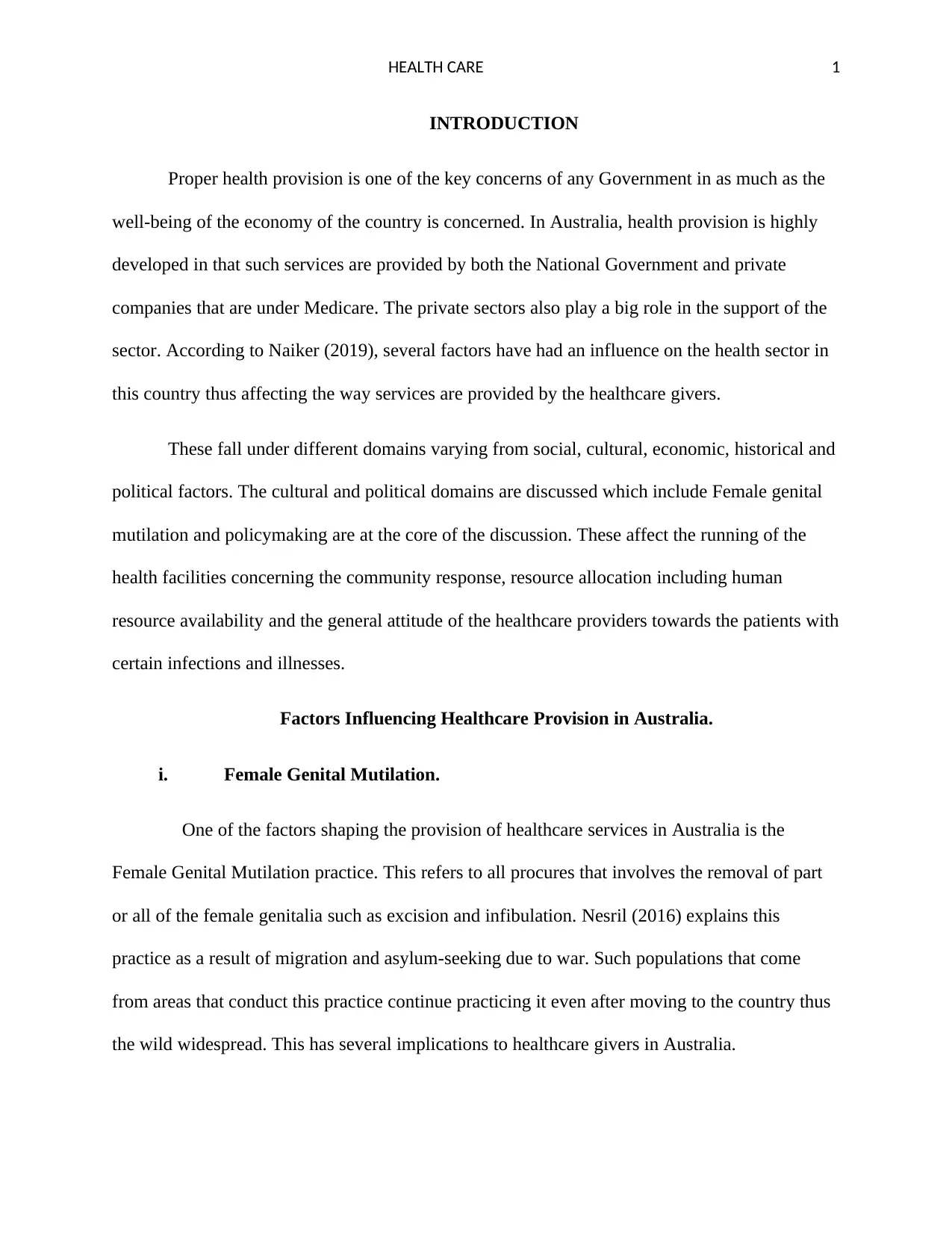
HEALTH CARE 1
INTRODUCTION
Proper health provision is one of the key concerns of any Government in as much as the
well-being of the economy of the country is concerned. In Australia, health provision is highly
developed in that such services are provided by both the National Government and private
companies that are under Medicare. The private sectors also play a big role in the support of the
sector. According to Naiker (2019), several factors have had an influence on the health sector in
this country thus affecting the way services are provided by the healthcare givers.
These fall under different domains varying from social, cultural, economic, historical and
political factors. The cultural and political domains are discussed which include Female genital
mutilation and policymaking are at the core of the discussion. These affect the running of the
health facilities concerning the community response, resource allocation including human
resource availability and the general attitude of the healthcare providers towards the patients with
certain infections and illnesses.
Factors Influencing Healthcare Provision in Australia.
i. Female Genital Mutilation.
One of the factors shaping the provision of healthcare services in Australia is the
Female Genital Mutilation practice. This refers to all procures that involves the removal of part
or all of the female genitalia such as excision and infibulation. Nesril (2016) explains this
practice as a result of migration and asylum-seeking due to war. Such populations that come
from areas that conduct this practice continue practicing it even after moving to the country thus
the wild widespread. This has several implications to healthcare givers in Australia.
INTRODUCTION
Proper health provision is one of the key concerns of any Government in as much as the
well-being of the economy of the country is concerned. In Australia, health provision is highly
developed in that such services are provided by both the National Government and private
companies that are under Medicare. The private sectors also play a big role in the support of the
sector. According to Naiker (2019), several factors have had an influence on the health sector in
this country thus affecting the way services are provided by the healthcare givers.
These fall under different domains varying from social, cultural, economic, historical and
political factors. The cultural and political domains are discussed which include Female genital
mutilation and policymaking are at the core of the discussion. These affect the running of the
health facilities concerning the community response, resource allocation including human
resource availability and the general attitude of the healthcare providers towards the patients with
certain infections and illnesses.
Factors Influencing Healthcare Provision in Australia.
i. Female Genital Mutilation.
One of the factors shaping the provision of healthcare services in Australia is the
Female Genital Mutilation practice. This refers to all procures that involves the removal of part
or all of the female genitalia such as excision and infibulation. Nesril (2016) explains this
practice as a result of migration and asylum-seeking due to war. Such populations that come
from areas that conduct this practice continue practicing it even after moving to the country thus
the wild widespread. This has several implications to healthcare givers in Australia.
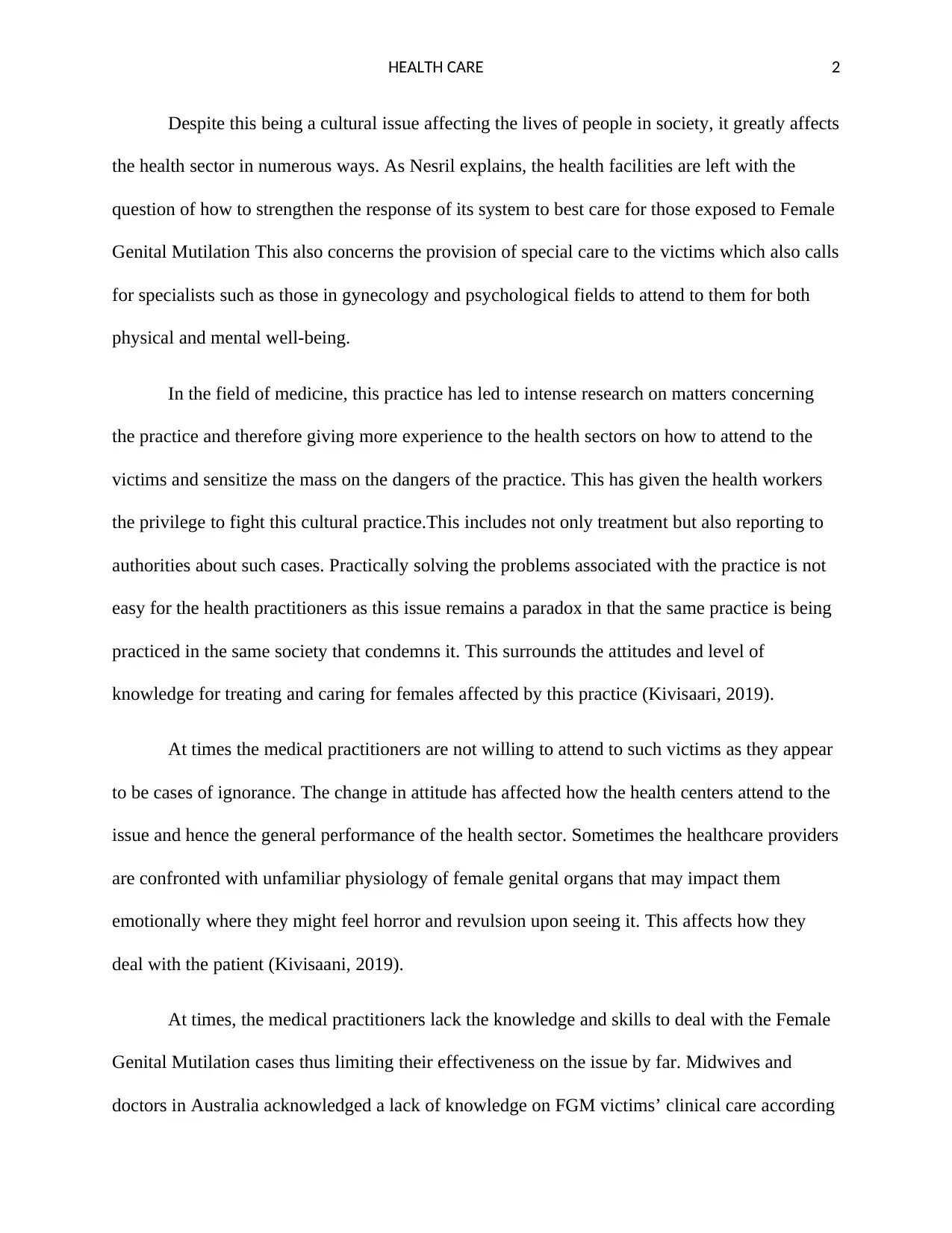
HEALTH CARE 2
Despite this being a cultural issue affecting the lives of people in society, it greatly affects
the health sector in numerous ways. As Nesril explains, the health facilities are left with the
question of how to strengthen the response of its system to best care for those exposed to Female
Genital Mutilation This also concerns the provision of special care to the victims which also calls
for specialists such as those in gynecology and psychological fields to attend to them for both
physical and mental well-being.
In the field of medicine, this practice has led to intense research on matters concerning
the practice and therefore giving more experience to the health sectors on how to attend to the
victims and sensitize the mass on the dangers of the practice. This has given the health workers
the privilege to fight this cultural practice.This includes not only treatment but also reporting to
authorities about such cases. Practically solving the problems associated with the practice is not
easy for the health practitioners as this issue remains a paradox in that the same practice is being
practiced in the same society that condemns it. This surrounds the attitudes and level of
knowledge for treating and caring for females affected by this practice (Kivisaari, 2019).
At times the medical practitioners are not willing to attend to such victims as they appear
to be cases of ignorance. The change in attitude has affected how the health centers attend to the
issue and hence the general performance of the health sector. Sometimes the healthcare providers
are confronted with unfamiliar physiology of female genital organs that may impact them
emotionally where they might feel horror and revulsion upon seeing it. This affects how they
deal with the patient (Kivisaani, 2019).
At times, the medical practitioners lack the knowledge and skills to deal with the Female
Genital Mutilation cases thus limiting their effectiveness on the issue by far. Midwives and
doctors in Australia acknowledged a lack of knowledge on FGM victims’ clinical care according
Despite this being a cultural issue affecting the lives of people in society, it greatly affects
the health sector in numerous ways. As Nesril explains, the health facilities are left with the
question of how to strengthen the response of its system to best care for those exposed to Female
Genital Mutilation This also concerns the provision of special care to the victims which also calls
for specialists such as those in gynecology and psychological fields to attend to them for both
physical and mental well-being.
In the field of medicine, this practice has led to intense research on matters concerning
the practice and therefore giving more experience to the health sectors on how to attend to the
victims and sensitize the mass on the dangers of the practice. This has given the health workers
the privilege to fight this cultural practice.This includes not only treatment but also reporting to
authorities about such cases. Practically solving the problems associated with the practice is not
easy for the health practitioners as this issue remains a paradox in that the same practice is being
practiced in the same society that condemns it. This surrounds the attitudes and level of
knowledge for treating and caring for females affected by this practice (Kivisaari, 2019).
At times the medical practitioners are not willing to attend to such victims as they appear
to be cases of ignorance. The change in attitude has affected how the health centers attend to the
issue and hence the general performance of the health sector. Sometimes the healthcare providers
are confronted with unfamiliar physiology of female genital organs that may impact them
emotionally where they might feel horror and revulsion upon seeing it. This affects how they
deal with the patient (Kivisaani, 2019).
At times, the medical practitioners lack the knowledge and skills to deal with the Female
Genital Mutilation cases thus limiting their effectiveness on the issue by far. Midwives and
doctors in Australia acknowledged a lack of knowledge on FGM victims’ clinical care according
⊘ This is a preview!⊘
Do you want full access?
Subscribe today to unlock all pages.

Trusted by 1+ million students worldwide
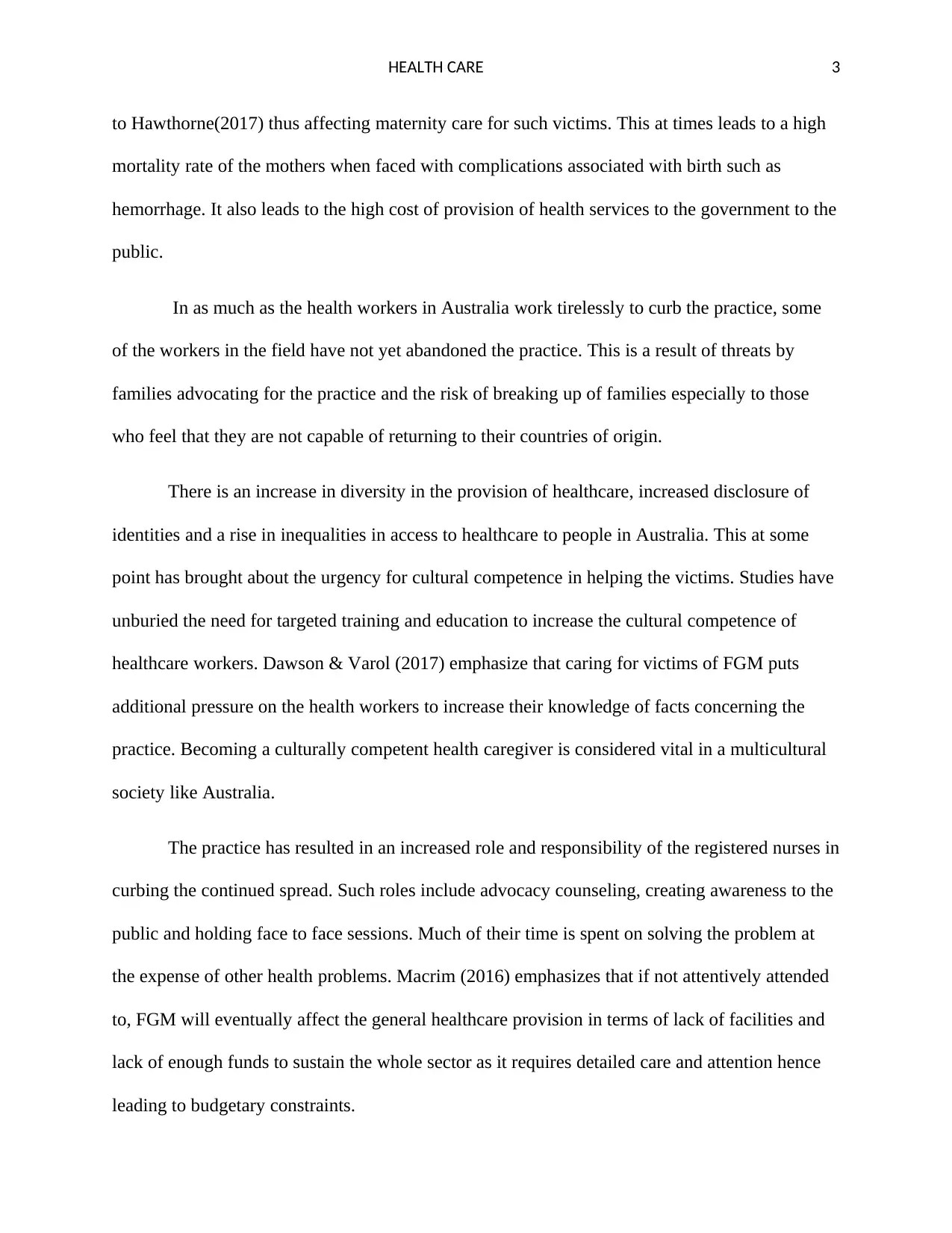
HEALTH CARE 3
to Hawthorne(2017) thus affecting maternity care for such victims. This at times leads to a high
mortality rate of the mothers when faced with complications associated with birth such as
hemorrhage. It also leads to the high cost of provision of health services to the government to the
public.
In as much as the health workers in Australia work tirelessly to curb the practice, some
of the workers in the field have not yet abandoned the practice. This is a result of threats by
families advocating for the practice and the risk of breaking up of families especially to those
who feel that they are not capable of returning to their countries of origin.
There is an increase in diversity in the provision of healthcare, increased disclosure of
identities and a rise in inequalities in access to healthcare to people in Australia. This at some
point has brought about the urgency for cultural competence in helping the victims. Studies have
unburied the need for targeted training and education to increase the cultural competence of
healthcare workers. Dawson & Varol (2017) emphasize that caring for victims of FGM puts
additional pressure on the health workers to increase their knowledge of facts concerning the
practice. Becoming a culturally competent health caregiver is considered vital in a multicultural
society like Australia.
The practice has resulted in an increased role and responsibility of the registered nurses in
curbing the continued spread. Such roles include advocacy counseling, creating awareness to the
public and holding face to face sessions. Much of their time is spent on solving the problem at
the expense of other health problems. Macrim (2016) emphasizes that if not attentively attended
to, FGM will eventually affect the general healthcare provision in terms of lack of facilities and
lack of enough funds to sustain the whole sector as it requires detailed care and attention hence
leading to budgetary constraints.
to Hawthorne(2017) thus affecting maternity care for such victims. This at times leads to a high
mortality rate of the mothers when faced with complications associated with birth such as
hemorrhage. It also leads to the high cost of provision of health services to the government to the
public.
In as much as the health workers in Australia work tirelessly to curb the practice, some
of the workers in the field have not yet abandoned the practice. This is a result of threats by
families advocating for the practice and the risk of breaking up of families especially to those
who feel that they are not capable of returning to their countries of origin.
There is an increase in diversity in the provision of healthcare, increased disclosure of
identities and a rise in inequalities in access to healthcare to people in Australia. This at some
point has brought about the urgency for cultural competence in helping the victims. Studies have
unburied the need for targeted training and education to increase the cultural competence of
healthcare workers. Dawson & Varol (2017) emphasize that caring for victims of FGM puts
additional pressure on the health workers to increase their knowledge of facts concerning the
practice. Becoming a culturally competent health caregiver is considered vital in a multicultural
society like Australia.
The practice has resulted in an increased role and responsibility of the registered nurses in
curbing the continued spread. Such roles include advocacy counseling, creating awareness to the
public and holding face to face sessions. Much of their time is spent on solving the problem at
the expense of other health problems. Macrim (2016) emphasizes that if not attentively attended
to, FGM will eventually affect the general healthcare provision in terms of lack of facilities and
lack of enough funds to sustain the whole sector as it requires detailed care and attention hence
leading to budgetary constraints.
Paraphrase This Document
Need a fresh take? Get an instant paraphrase of this document with our AI Paraphraser
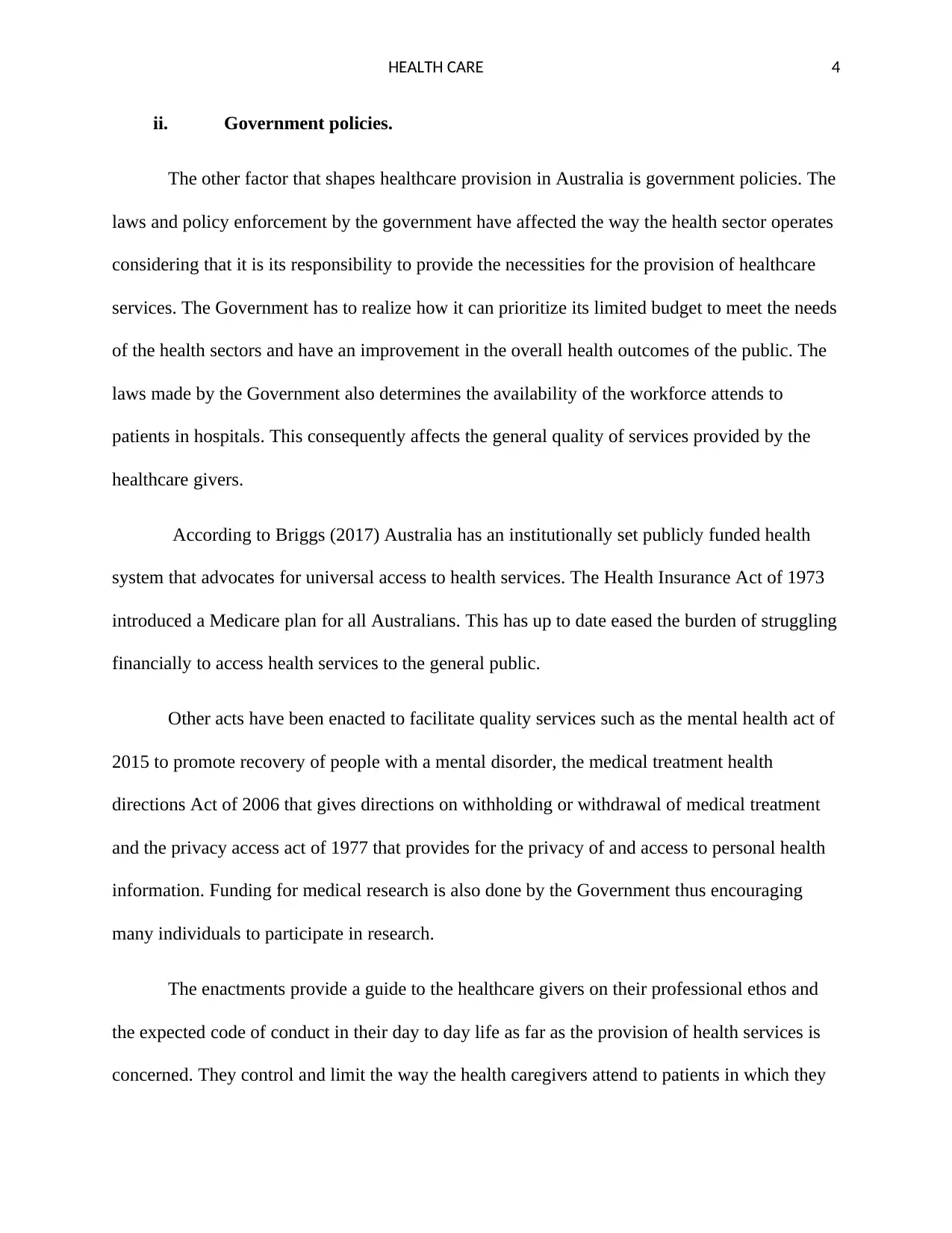
HEALTH CARE 4
ii. Government policies.
The other factor that shapes healthcare provision in Australia is government policies. The
laws and policy enforcement by the government have affected the way the health sector operates
considering that it is its responsibility to provide the necessities for the provision of healthcare
services. The Government has to realize how it can prioritize its limited budget to meet the needs
of the health sectors and have an improvement in the overall health outcomes of the public. The
laws made by the Government also determines the availability of the workforce attends to
patients in hospitals. This consequently affects the general quality of services provided by the
healthcare givers.
According to Briggs (2017) Australia has an institutionally set publicly funded health
system that advocates for universal access to health services. The Health Insurance Act of 1973
introduced a Medicare plan for all Australians. This has up to date eased the burden of struggling
financially to access health services to the general public.
Other acts have been enacted to facilitate quality services such as the mental health act of
2015 to promote recovery of people with a mental disorder, the medical treatment health
directions Act of 2006 that gives directions on withholding or withdrawal of medical treatment
and the privacy access act of 1977 that provides for the privacy of and access to personal health
information. Funding for medical research is also done by the Government thus encouraging
many individuals to participate in research.
The enactments provide a guide to the healthcare givers on their professional ethos and
the expected code of conduct in their day to day life as far as the provision of health services is
concerned. They control and limit the way the health caregivers attend to patients in which they
ii. Government policies.
The other factor that shapes healthcare provision in Australia is government policies. The
laws and policy enforcement by the government have affected the way the health sector operates
considering that it is its responsibility to provide the necessities for the provision of healthcare
services. The Government has to realize how it can prioritize its limited budget to meet the needs
of the health sectors and have an improvement in the overall health outcomes of the public. The
laws made by the Government also determines the availability of the workforce attends to
patients in hospitals. This consequently affects the general quality of services provided by the
healthcare givers.
According to Briggs (2017) Australia has an institutionally set publicly funded health
system that advocates for universal access to health services. The Health Insurance Act of 1973
introduced a Medicare plan for all Australians. This has up to date eased the burden of struggling
financially to access health services to the general public.
Other acts have been enacted to facilitate quality services such as the mental health act of
2015 to promote recovery of people with a mental disorder, the medical treatment health
directions Act of 2006 that gives directions on withholding or withdrawal of medical treatment
and the privacy access act of 1977 that provides for the privacy of and access to personal health
information. Funding for medical research is also done by the Government thus encouraging
many individuals to participate in research.
The enactments provide a guide to the healthcare givers on their professional ethos and
the expected code of conduct in their day to day life as far as the provision of health services is
concerned. They control and limit the way the health caregivers attend to patients in which they
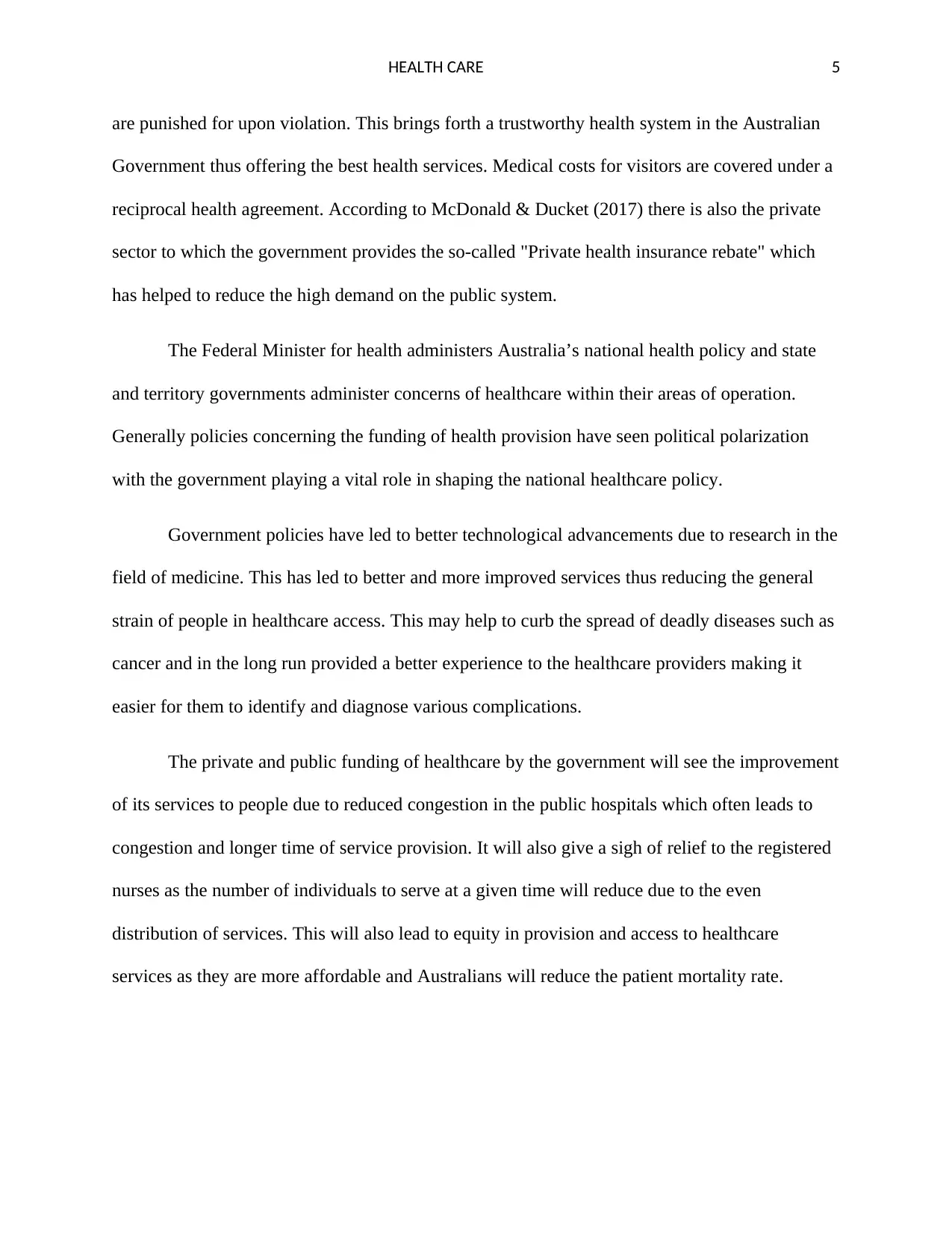
HEALTH CARE 5
are punished for upon violation. This brings forth a trustworthy health system in the Australian
Government thus offering the best health services. Medical costs for visitors are covered under a
reciprocal health agreement. According to McDonald & Ducket (2017) there is also the private
sector to which the government provides the so-called "Private health insurance rebate" which
has helped to reduce the high demand on the public system.
The Federal Minister for health administers Australia’s national health policy and state
and territory governments administer concerns of healthcare within their areas of operation.
Generally policies concerning the funding of health provision have seen political polarization
with the government playing a vital role in shaping the national healthcare policy.
Government policies have led to better technological advancements due to research in the
field of medicine. This has led to better and more improved services thus reducing the general
strain of people in healthcare access. This may help to curb the spread of deadly diseases such as
cancer and in the long run provided a better experience to the healthcare providers making it
easier for them to identify and diagnose various complications.
The private and public funding of healthcare by the government will see the improvement
of its services to people due to reduced congestion in the public hospitals which often leads to
congestion and longer time of service provision. It will also give a sigh of relief to the registered
nurses as the number of individuals to serve at a given time will reduce due to the even
distribution of services. This will also lead to equity in provision and access to healthcare
services as they are more affordable and Australians will reduce the patient mortality rate.
are punished for upon violation. This brings forth a trustworthy health system in the Australian
Government thus offering the best health services. Medical costs for visitors are covered under a
reciprocal health agreement. According to McDonald & Ducket (2017) there is also the private
sector to which the government provides the so-called "Private health insurance rebate" which
has helped to reduce the high demand on the public system.
The Federal Minister for health administers Australia’s national health policy and state
and territory governments administer concerns of healthcare within their areas of operation.
Generally policies concerning the funding of health provision have seen political polarization
with the government playing a vital role in shaping the national healthcare policy.
Government policies have led to better technological advancements due to research in the
field of medicine. This has led to better and more improved services thus reducing the general
strain of people in healthcare access. This may help to curb the spread of deadly diseases such as
cancer and in the long run provided a better experience to the healthcare providers making it
easier for them to identify and diagnose various complications.
The private and public funding of healthcare by the government will see the improvement
of its services to people due to reduced congestion in the public hospitals which often leads to
congestion and longer time of service provision. It will also give a sigh of relief to the registered
nurses as the number of individuals to serve at a given time will reduce due to the even
distribution of services. This will also lead to equity in provision and access to healthcare
services as they are more affordable and Australians will reduce the patient mortality rate.
⊘ This is a preview!⊘
Do you want full access?
Subscribe today to unlock all pages.

Trusted by 1+ million students worldwide
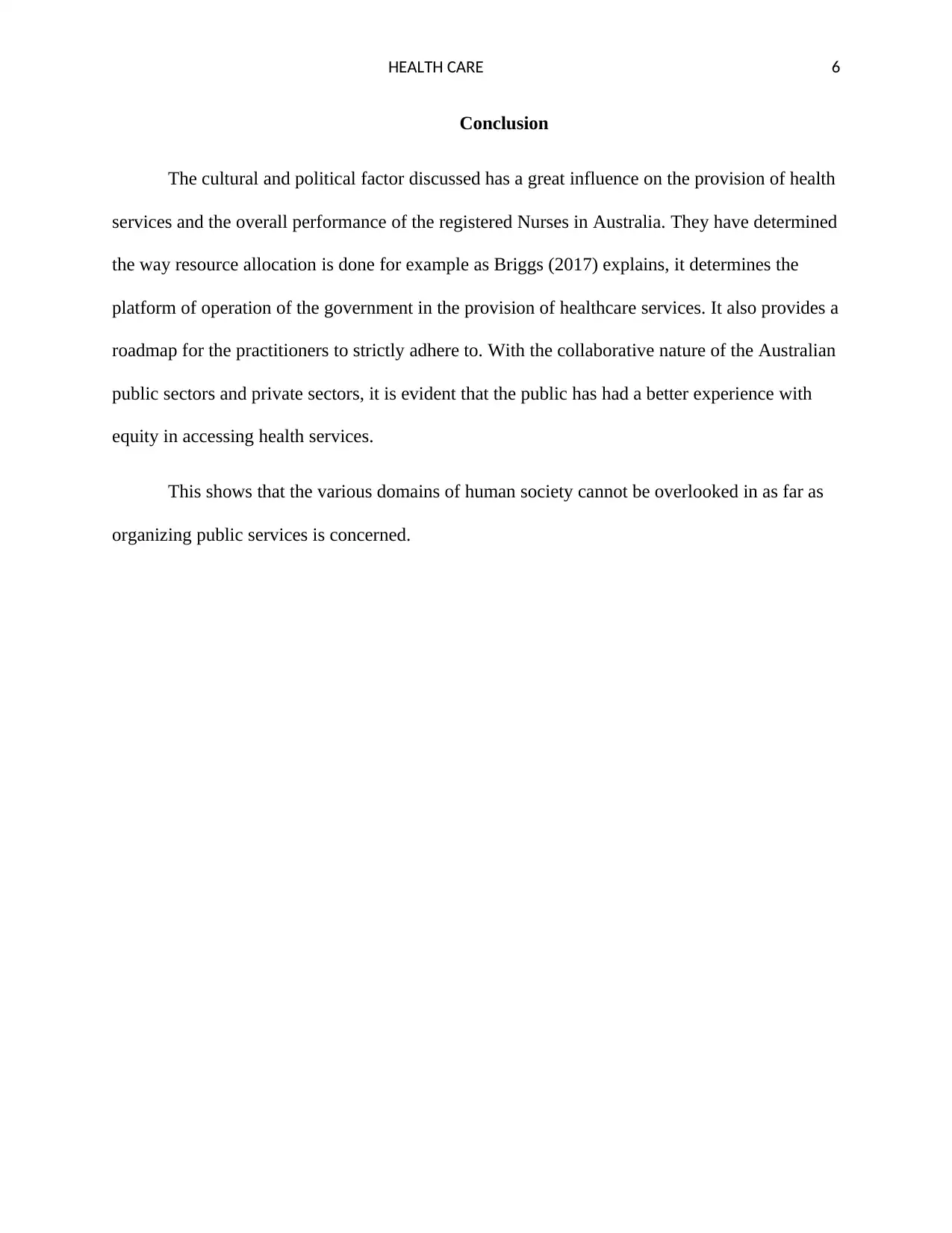
HEALTH CARE 6
Conclusion
The cultural and political factor discussed has a great influence on the provision of health
services and the overall performance of the registered Nurses in Australia. They have determined
the way resource allocation is done for example as Briggs (2017) explains, it determines the
platform of operation of the government in the provision of healthcare services. It also provides a
roadmap for the practitioners to strictly adhere to. With the collaborative nature of the Australian
public sectors and private sectors, it is evident that the public has had a better experience with
equity in accessing health services.
This shows that the various domains of human society cannot be overlooked in as far as
organizing public services is concerned.
Conclusion
The cultural and political factor discussed has a great influence on the provision of health
services and the overall performance of the registered Nurses in Australia. They have determined
the way resource allocation is done for example as Briggs (2017) explains, it determines the
platform of operation of the government in the provision of healthcare services. It also provides a
roadmap for the practitioners to strictly adhere to. With the collaborative nature of the Australian
public sectors and private sectors, it is evident that the public has had a better experience with
equity in accessing health services.
This shows that the various domains of human society cannot be overlooked in as far as
organizing public services is concerned.
Paraphrase This Document
Need a fresh take? Get an instant paraphrase of this document with our AI Paraphraser
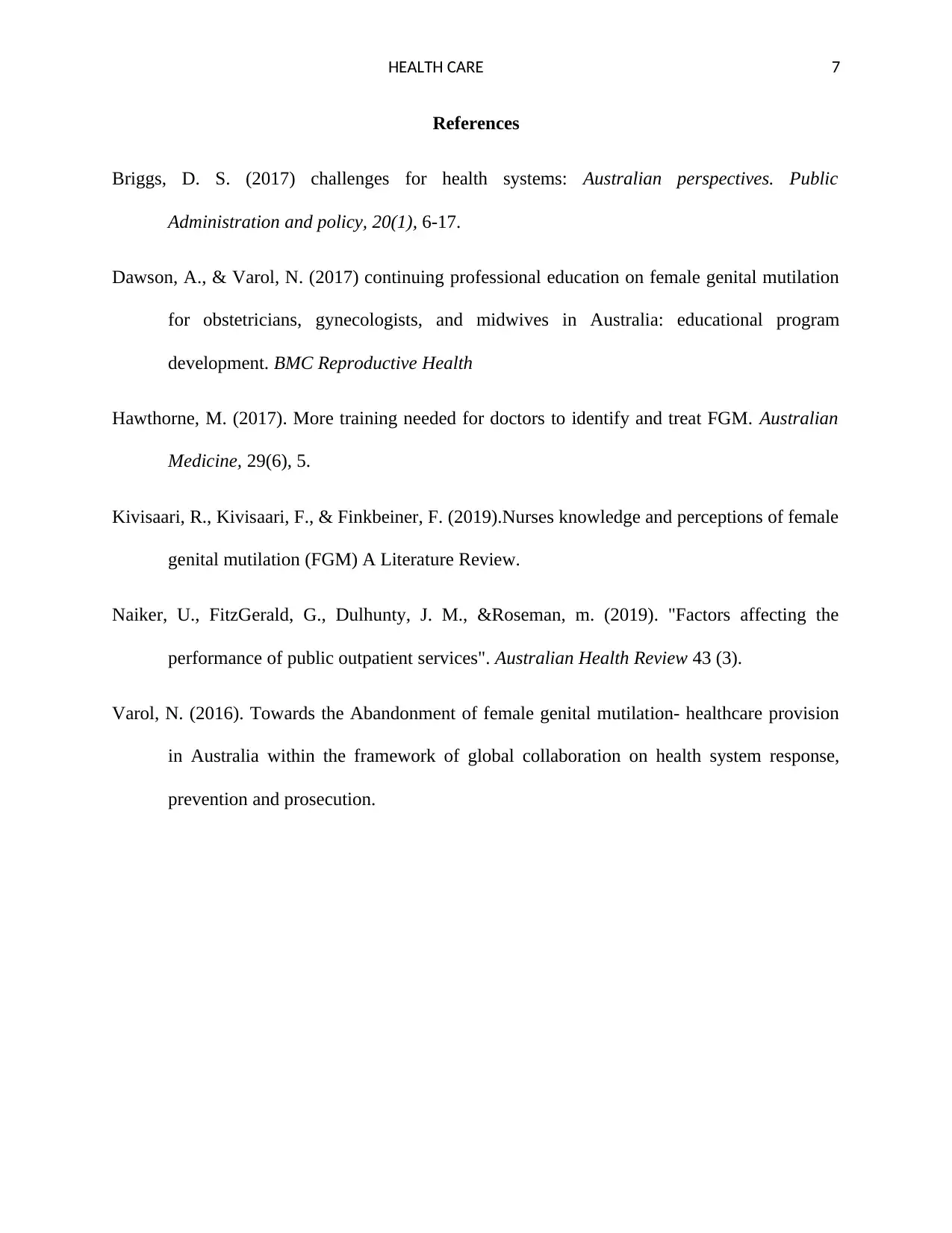
HEALTH CARE 7
References
Briggs, D. S. (2017) challenges for health systems: Australian perspectives. Public
Administration and policy, 20(1), 6-17.
Dawson, A., & Varol, N. (2017) continuing professional education on female genital mutilation
for obstetricians, gynecologists, and midwives in Australia: educational program
development. BMC Reproductive Health
Hawthorne, M. (2017). More training needed for doctors to identify and treat FGM. Australian
Medicine, 29(6), 5.
Kivisaari, R., Kivisaari, F., & Finkbeiner, F. (2019).Nurses knowledge and perceptions of female
genital mutilation (FGM) A Literature Review.
Naiker, U., FitzGerald, G., Dulhunty, J. M., &Roseman, m. (2019). "Factors affecting the
performance of public outpatient services". Australian Health Review 43 (3).
Varol, N. (2016). Towards the Abandonment of female genital mutilation- healthcare provision
in Australia within the framework of global collaboration on health system response,
prevention and prosecution.
References
Briggs, D. S. (2017) challenges for health systems: Australian perspectives. Public
Administration and policy, 20(1), 6-17.
Dawson, A., & Varol, N. (2017) continuing professional education on female genital mutilation
for obstetricians, gynecologists, and midwives in Australia: educational program
development. BMC Reproductive Health
Hawthorne, M. (2017). More training needed for doctors to identify and treat FGM. Australian
Medicine, 29(6), 5.
Kivisaari, R., Kivisaari, F., & Finkbeiner, F. (2019).Nurses knowledge and perceptions of female
genital mutilation (FGM) A Literature Review.
Naiker, U., FitzGerald, G., Dulhunty, J. M., &Roseman, m. (2019). "Factors affecting the
performance of public outpatient services". Australian Health Review 43 (3).
Varol, N. (2016). Towards the Abandonment of female genital mutilation- healthcare provision
in Australia within the framework of global collaboration on health system response,
prevention and prosecution.
1 out of 8
Related Documents
Your All-in-One AI-Powered Toolkit for Academic Success.
+13062052269
info@desklib.com
Available 24*7 on WhatsApp / Email
![[object Object]](/_next/static/media/star-bottom.7253800d.svg)
Unlock your academic potential
Copyright © 2020–2025 A2Z Services. All Rights Reserved. Developed and managed by ZUCOL.





